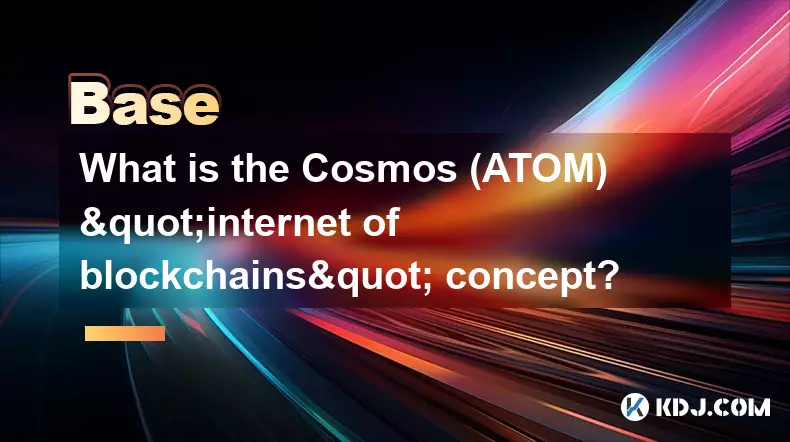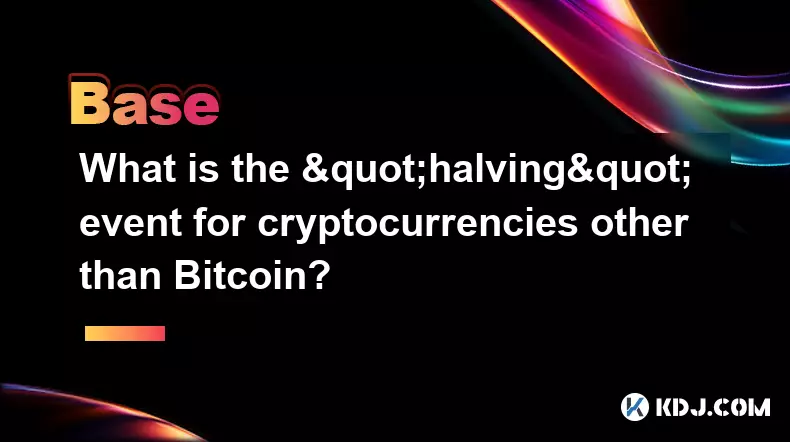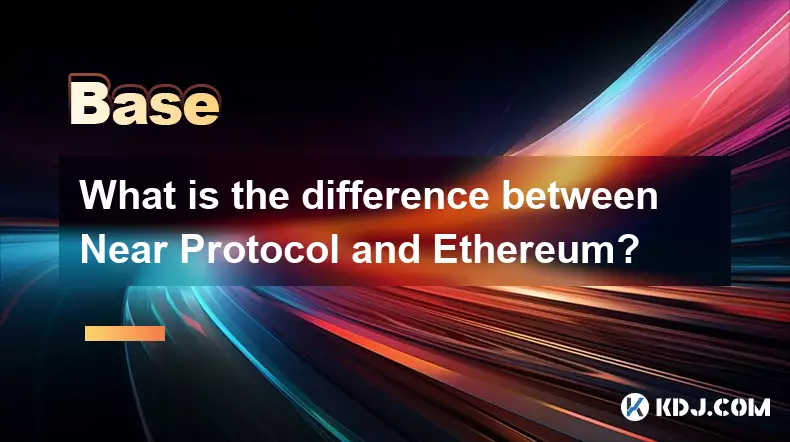-
 bitcoin
bitcoin $115178.669275 USD
3.07% -
 ethereum
ethereum $4187.145122 USD
5.98% -
 tether
tether $0.999974 USD
-0.02% -
 xrp
xrp $2.657749 USD
1.76% -
 bnb
bnb $1143.755467 USD
1.88% -
 solana
solana $204.642189 USD
5.78% -
 usd-coin
usd-coin $0.999808 USD
-0.01% -
 dogecoin
dogecoin $0.207825 USD
5.98% -
 tron
tron $0.300913 USD
1.42% -
 cardano
cardano $0.687188 USD
5.24% -
 hyperliquid
hyperliquid $48.081828 USD
8.50% -
 chainlink
chainlink $18.790575 USD
4.94% -
 bitcoin-cash
bitcoin-cash $558.997512 USD
8.92% -
 stellar
stellar $0.333150 USD
2.01% -
 ethena-usde
ethena-usde $0.999206 USD
0.00%
What is the Cosmos (ATOM) "internet of blockchains" concept?
Cosmos enables sovereign, scalable blockchains to interoperate via IBC, creating an "internet of blockchains" where ATOM secures the hub and empowers governance. (154 characters)
Oct 22, 2025 at 11:36 am

Understanding the Cosmos 'Internet of Blockchains' Vision
1. The Cosmos network is designed to solve fundamental issues in the blockchain space, particularly interoperability and scalability. Unlike traditional blockchains that operate in isolation, Cosmos enables independent blockchains to communicate and transfer data or assets seamlessly. This interconnected framework is what earns it the nickname 'internet of blockchains.'
2. At its core, Cosmos uses a modular architecture built with the Cosmos SDK, allowing developers to create custom blockchains tailored to specific use cases. These individual chains, known as zones, can maintain sovereignty while still being able to interact with others through a central hub—the Cosmos Hub, which runs on the ATOM token.
3. Inter-blockchain Communication (IBC) protocol is the technological backbone enabling this ecosystem. IBC allows secure message passing and asset transfers between connected chains without requiring a centralized intermediary. This trust-minimized communication system relies on cryptographic proofs and consensus verification across chains.
4. Each blockchain within Cosmos can have its own governance, tokenomics, and validation set. This flexibility supports innovation while preserving decentralization. Chains are not forced into a one-size-fits-all model, empowering projects to optimize performance, security, and functionality according to their needs.
5. The vision extends beyond simple token swaps. Cosmos aims to foster an ecosystem where decentralized applications can leverage capabilities across multiple specialized chains—such as a DeFi application sourcing price data from an oracle chain and settling transactions on a high-throughput payment chain.
The Role of ATOM in the Cosmos Ecosystem
1. ATOM is the native staking token of the Cosmos Hub and plays a crucial role in securing the network. Validators must stake ATOM to participate in consensus, and users delegate their ATOM to validators to earn rewards and contribute to network security.
2. Transaction fees on the Cosmos Hub are paid in ATOM, reinforcing its utility within the ecosystem. As more zones connect to the hub and traffic increases, demand for ATOM grows due to its central position in facilitating cross-chain activity.
3. ATOM holders also participate in governance by voting on proposals that affect the Cosmos Hub’s development, upgrades, and parameter changes. This decentralized decision-making process ensures that the community has direct influence over the direction of the network.
4. Inflationary issuance of ATOM incentivizes staking and helps maintain long-term security. The rate adjusts dynamically based on staking participation, encouraging broader distribution and reducing the risk of centralization among large stakeholders.
5. While ATOM itself does not serve as a universal currency across all zones, its importance lies in anchoring trust and connectivity within the broader interchain structure. Its value accrues through usage, governance, and the economic activity routed through the Cosmos Hub.
How Cosmos Enables Scalability and Sovereignty
1. Traditional blockchains face bottlenecks because every node processes every transaction. Cosmos circumvents this by allowing parallel blockchains to run independently, each handling its own workload. This sharding-like approach significantly improves overall throughput.
2. Developers can launch application-specific blockchains instead of building smart contracts on general-purpose platforms. This means they can fine-tune parameters like block time, fee structure, and consensus rules to match their application's requirements.
3. Sovereignty is preserved because each zone controls its own upgrade path and validator set, avoiding hard forks imposed by external ecosystems. Projects do not need to rely on another chain’s roadmap or governance outcomes to evolve.
4. Security is maintained through proof-of-stake mechanisms and cryptographic verification via IBC. Even though chains operate autonomously, they can verify each other’s state transitions securely, ensuring integrity during cross-chain interactions.
5. The modularity of the Cosmos SDK allows integration of various consensus algorithms, virtual machines, and networking layers. This adaptability makes it feasible to deploy lightweight chains for niche applications or high-performance environments without compromising compatibility.
Frequently Asked Questions
What makes Cosmos different from other interoperability solutions?Cosmos focuses on sovereign, application-specific blockchains connected via IBC, rather than relying on bridges or wrapped assets. It emphasizes minimal trust assumptions and end-to-end cryptographic verification between chains, reducing reliance on third-party intermediaries.
Can any blockchain join the Cosmos network?Blockchains built with the Cosmos SDK can natively integrate. Others can connect if they implement IBC, either directly or through relays. Several non-Cosmos chains have adopted IBC through implementations like Stargate, expanding the interchain network.
Is Cosmos competing with Ethereum?Rather than direct competition, Cosmos offers an alternative paradigm. While Ethereum emphasizes global state and shared security via rollups, Cosmos prioritizes autonomy and specialization. Many projects in Cosmos complement Ethereum by handling specific tasks more efficiently.
How does Cosmos handle security across interconnected chains?Security is localized per chain, meaning each zone secures itself through its validator set. Cross-chain communication relies on light clients and Merkle proofs to verify remote chain states, ensuring that no single point of failure compromises the entire network.
Disclaimer:info@kdj.com
The information provided is not trading advice. kdj.com does not assume any responsibility for any investments made based on the information provided in this article. Cryptocurrencies are highly volatile and it is highly recommended that you invest with caution after thorough research!
If you believe that the content used on this website infringes your copyright, please contact us immediately (info@kdj.com) and we will delete it promptly.
- Essex Post Office, 5p Coins, and King Charles: A Royal Mint Revelation!
- 2025-10-23 10:30:16
- Waymo's Newark Airport AV Tests: Alphabet's AI Gamble Pays Off?
- 2025-10-23 10:30:16
- King Charles 5p Coins: A Royal Flush in Your Pocket?
- 2025-10-23 10:35:18
- Solana, Crypto Advisory, and Forward Industries: A New York Minute on the Future of Finance
- 2025-10-23 08:51:22
- MAGACOIN: Ethereum Whales Dive into the Hottest Presale of 2025
- 2025-10-23 08:51:22
- Kadena's End of the Road? KDA Token Plummets Amid Project Abandonment
- 2025-10-23 08:55:34
Related knowledge

How do decentralized identity (DID) solutions work?
Oct 14,2025 at 11:36pm
Understanding Decentralized Identity in the Blockchain Ecosystem1. Decentralized identity (DID) solutions are built on blockchain networks, allowing i...

What is the "halving" event for cryptocurrencies other than Bitcoin?
Oct 25,2025 at 12:19pm
Decentralized Exchanges Gain Momentum in 20241. Decentralized exchanges (DEXs) have seen a surge in trading volume as users prioritize control over th...

What is the difference between Near Protocol and Ethereum?
Oct 15,2025 at 08:01am
Near Protocol and Ethereum: Core Architectural Differences1. Near Protocol operates on a sharded blockchain architecture known as Nightshade, which al...

What does it mean for code to be "open source" in crypto?
Oct 12,2025 at 01:54pm
Understanding Open Source in the Cryptocurrency Ecosystem1. In the context of cryptocurrency, open source refers to software whose code is publicly ac...

What is the purpose of a "testnet"?
Oct 12,2025 at 09:01am
Understanding the Role of Testnets in Blockchain Development1. A testnet serves as a parallel version of a blockchain network, designed specifically f...

How to avoid phishing scams in crypto?
Oct 13,2025 at 06:18pm
Understanding Common Crypto Phishing Tactics1. Cybercriminals frequently use fake websites that mirror legitimate crypto exchanges or wallet platforms...

How do decentralized identity (DID) solutions work?
Oct 14,2025 at 11:36pm
Understanding Decentralized Identity in the Blockchain Ecosystem1. Decentralized identity (DID) solutions are built on blockchain networks, allowing i...

What is the "halving" event for cryptocurrencies other than Bitcoin?
Oct 25,2025 at 12:19pm
Decentralized Exchanges Gain Momentum in 20241. Decentralized exchanges (DEXs) have seen a surge in trading volume as users prioritize control over th...

What is the difference between Near Protocol and Ethereum?
Oct 15,2025 at 08:01am
Near Protocol and Ethereum: Core Architectural Differences1. Near Protocol operates on a sharded blockchain architecture known as Nightshade, which al...

What does it mean for code to be "open source" in crypto?
Oct 12,2025 at 01:54pm
Understanding Open Source in the Cryptocurrency Ecosystem1. In the context of cryptocurrency, open source refers to software whose code is publicly ac...

What is the purpose of a "testnet"?
Oct 12,2025 at 09:01am
Understanding the Role of Testnets in Blockchain Development1. A testnet serves as a parallel version of a blockchain network, designed specifically f...

How to avoid phishing scams in crypto?
Oct 13,2025 at 06:18pm
Understanding Common Crypto Phishing Tactics1. Cybercriminals frequently use fake websites that mirror legitimate crypto exchanges or wallet platforms...
See all articles










































































